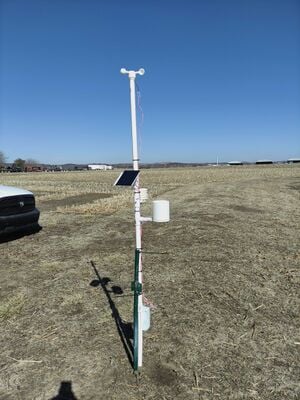
More information about this project can be found in the open-source project on | git hub
Motive[edit | edit source]
We all know that meteorological information is very important for any agricultural research and management. However, commercial weather stations are very expensive. This can become a problem when a high amount is needed or in a low-budget community. Thinking on that, this low-cost weather station was developed.
Objective[edit | edit source]
Develop a weather station to collect air temperature and humidity, luminosity, wind speed, and precipitation in the field using Arduino and low-cost sensors. It is energized with a solar panel and batteries. All data is stored in a microSD card along with the date and time.
Working-flow[edit | edit source]
Into a loop that repeats every 5 minutes, the sensors get the data values and store in a .txt file. The .txt file is in the microSD card. Along with the sensors' reading data, the date and time are also sent to the .txt file.
The final .txt file is a line per reading with date, hour, and sensors' data, all separated by commas.
Algorithm[edit | edit source]
The algorithm was made in C++ using Arduino IDE, since it is for Arduino. It is located in the Algorithm/Programa_o folder. The algorithm is structured as follows:
- Inclusion of libraries for SD card, RTC clock, temperature and humidity sensor;
- Declaration of variables for each sensor and module;
- Setup, that only runs once when the Arduino is restarted. On this function, i) the pin for the Pluviomether and Anemomether reed switchs' are declared; ii) initialize the microSD card; iii) the clock is initialized and adjusted only once; iV) the temperature and humidity sensor is initialized;
- Loop, that keeps running. On this function, i) The super delay function is inserted to work every 5 minutes, ii) the Anemomether data (wind speed) is collected and adjusted, iii) the luminosity data is collected and adjusted, iv) temperature and humidity data is collected, v) the Pluviomether data is collected (rain) and adjusted, vi) Date and Time variables are collected and stored, vii) the .txt file in the microSD card is opened and all variables are stored into it, closing the .txt after that;
- Super delay function. It is created to take readings of rain and wind every time and just after a time, saves the data in the microSD card. To count the rain and wind, it verifies the state of the reed switch, and if it is changed, it is counted, and the value changes.
Structure and Circuit board[edit | edit source]
To reduce costs, the weather station was all structured in PVC pipes and buried in the soil. The structures to hold the solar panel and the sensors were both obtained from the internet and developed by the author. To avoid the high number of wires, a PCB was developed and manufactured by the authors.
Validation and outcomes[edit | edit source]
Even though it was made using PVC pipes and low-cost sensors, the weather station resisted the winter, spring, and summer in Kansas. The location had temperatures ranging from 40 Celsius degrees to -15 Celsius degrees, in addition to a tornado.
The data collected during the whole experiment presented similar results to the reality, with a low number of outliers.
Difficulties and future works[edit | edit source]
This project presented issues related to the battery. Sometimes, the battery couldn't last an entire night, missing some data between 5 am and 8 am.
For future works, we targeted the addition of a soil moisture sensor, battery optimization, a better-looking design to reduce costs and labor working with pipes, and finally integration with the internet to store the data on a remote database.
As a major ambition, future work could be to develop a network of these low-cost weather stations to monitor the weather in locations with a lot of micro-climate variation which can potentially impact agriculture.